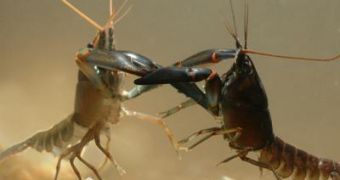It is known that an aggressive attitude works amongst many human individuals as in many cases intimidation and threats, common throughout society, bring results when applied against weaker individuals, whether it's in the school playground, sporting arena or boardroom.
And this weakness is not a physical but a mental one.
But do not think that this type of behavior is restricted only among humans.
Trickster behavior can be found also amongst many species: they signal a fake superior strength to competitors to eliminate them from food, territory and mating system.
This is contrary to the Darwinian selection theory that says that strength signaling is a fair way of assessing the fitness of an individual.
To its surprise, a research team from University of Queensland led by Dr Robbie Wilson has discovered that dishonest signals are employed routinely during dominance disputes by male Australian crayfish.
The tricking behavior is amazing in an invertebrate and regarded as displaying simpler behaviors.
Crayfish have a natural aggressive behavior and will fight restlessly over almost anything!
The males have enlarged front claws that they employ to intimidate and fight with their competing males.
Wilson's team focused on understanding the main factors that determine the social dominance in these aggressive animals.
The researchers measured the size and strength of claws of both male and female crayfish, and then assessed how these elements correlated with dominance.
The crayfish male employs claw size factor to assess the winners of the most aggressive fights and the female crayfish also used this criteria as an honest indicator of the strength of the males.
But this factor proved to be deceiving.
Males were often bluffing their competitors with weak claws to get higher on the hierarchy scale, as the claws were employed more for intimidation than actual strength.
"Male crayfish lie and cheat their way to the top, whilst females appear to be honest displayers of their own strength", said Wilson.
"This is important work showing that dishonesty is commonly used by animals during fights. We already knew humans often use dishonesty during disputes, but our results suggest cheating may play a more important role in animal communication than previously imagined."

 14 DAY TRIAL //
14 DAY TRIAL //